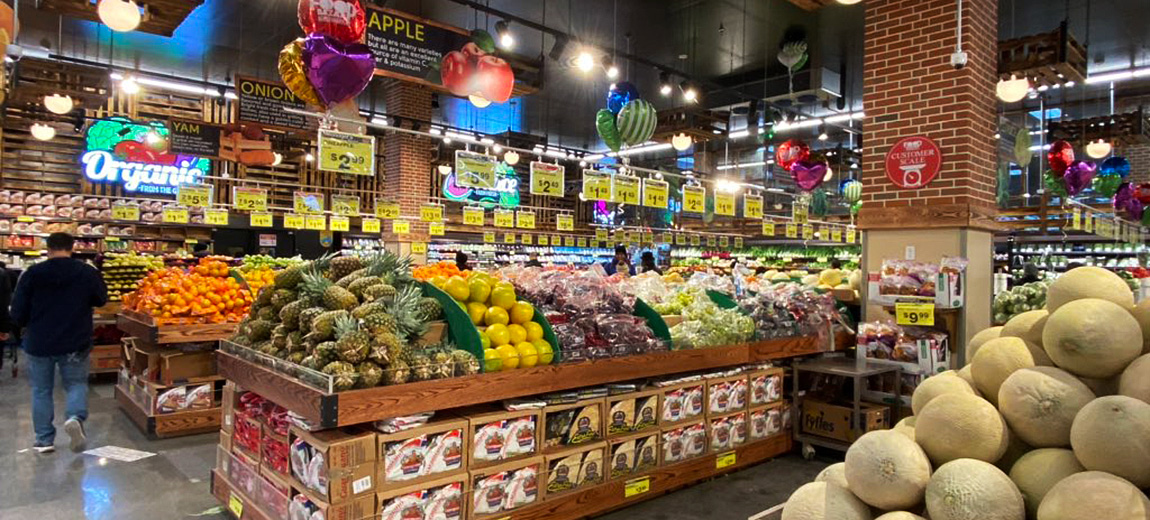The company opened its fifth location at 22 E. 151st St. in the Bronx shortly after the new year. At 83,000 square feet, it’s the largest supermarket in the borough.
For Marlene Cintron, president of the Bronx Overall Economic Corporation, that cold breeze is a breath of fresh air. It’s never made sense to her why just three miles from the Hunts Point Cooperative Market, which provides meat, fish and produce to shops across the entire East Coast, it’s difficult to find fresh food. She says that while there are other supermarkets in the area, they’re sometimes inadequate to serve the community’s needs.
“These guys get it, there’s not much that you would want as a fresh product that’s not in their supermarkets,” said Cintron of Food Bazaar. “It’s extremely important for us to get the same amount and quality of fresh fruits and produce as the rest of the city gets.”
In addition to produce, there are also meat and seafood departments, among others. The Boogie Down Food Hall, which will feature more than a dozen food vendors, is expected to open in the Spring, in an area just beyond the cashiers.
“We go to great lengths in order to provide each of the communities that we serve with the flavors that they love and recall from ‘back home,’” said Suzanne Kuczun, director of marketing and development of Bogopa Service Corp., Food Bazaar’s parent company, headquartered in Brooklyn. The store, she adds, employs nearly 200 people.
With obesity rates higher than the state average, the need for healthier food options in the Bronx isn’t a new development. The dearth of supermarkets in the area means that much of the borough is serviced by bodega corner stores, which often have limited fresh produce available.
There are 25 bodegas to each supermarket in Community District 1 (Mott Haven, Melrose, Port Morris), and just 5 percent of food establishments in the district are supermarkets, according to the 2018 Community Health Profile.
The city’s Economic Development Corp. offers zoning and discretionary tax incentives through its Food Retail Expansion to Support Health (FRESH) program, for supermarkets in eligible areas, like the entire South Bronx. Twenty-two projects have so far been approved by the EDC. Some of the prerequisites include allocating at least 500 square feet for fresh produce, and having at least 5,000 square feet of retail space for food and nonfood grocery products.
What, then, is keeping more supermarkets from opening up? Lisa Sorin, president of the Bronx Chamber of Commerce, says that starting any kind of business in New York City is “very difficult” due to starting costs, regulations and paperwork.
“Something this big in a community that’s ever-growing like Mott Haven…you’ve got a real good target audience. The chances of this not surviving are very small. But when you ask a supermarket to go into small commercial corridors, where the costs are so high, where the margins of profit are so low, you almost have to say is it worth it?,” said Sorin.
“I don’t think it’s that people don’t want to come,” she added, “it’s that we as a city have to figure out how to make it easier for businesses coming to our communities.”
Still, even if more “big box” stores like Food Bazaar come into the area, business leaders say there is plenty of space for them to co-exist with bodegas, which can be found on most Bronx blocks and are usually family owned.
“It was the bodeguero who provided credit for the people in the community that they knew, it was my local bodega where I used to leave my house keys so that my daughter after school could pick them up,” said Cintron.
“The bodega is really the entity that has the closer relationship with the residents in the borough.”
Sorin agrees.
“The bodegas are just a part of the community and assist in making your life easier because they’re close by. Food Bazaar is a destination place where you’re making a plan to go there and do your shopping and look around and buy everything that you need to buy in large quantities,” said Sorin.
“It’s apples and oranges, no pun intended.”

